My quick and delicious Miso Ramen recipe with an intensely savory broth is ready in less than 30 minutes. With 5 key soup broth ingredients, this piping-hot bowl of soulful goodness is sure to satisfy your ramen cravings!
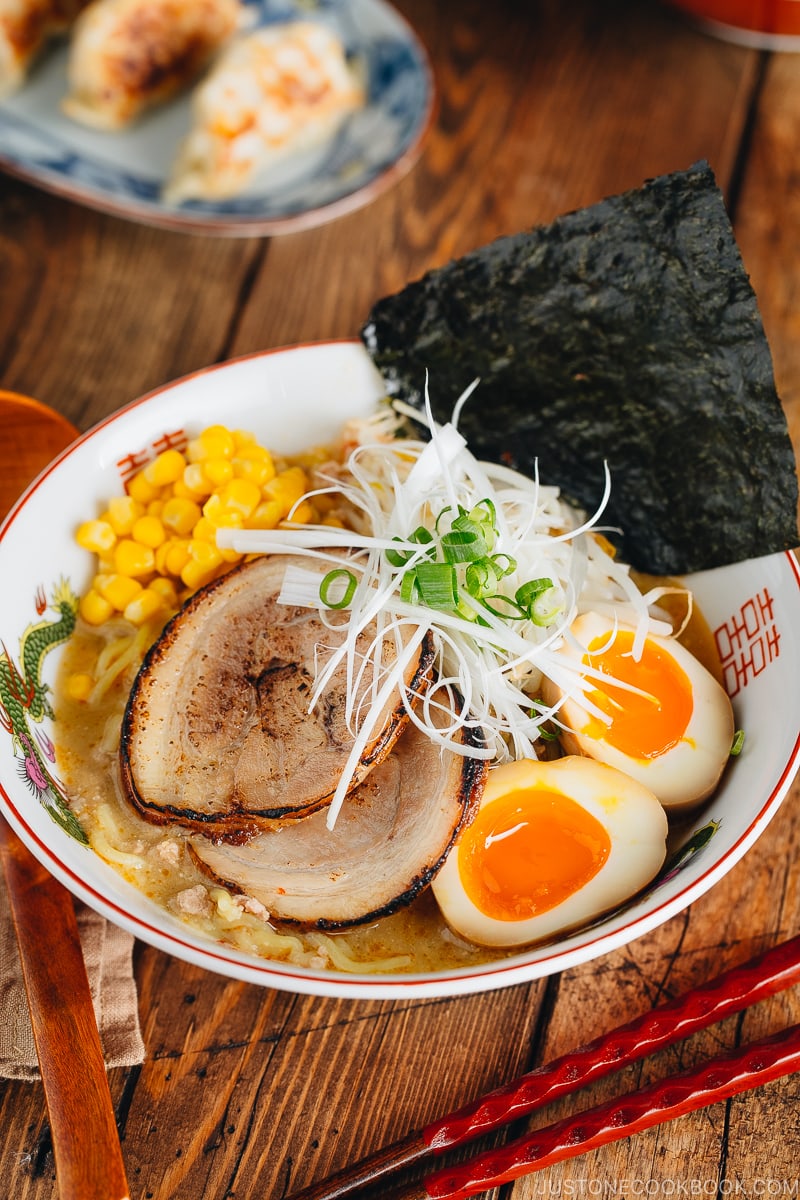
When you’re in Japan, you will quickly learn that there are 3 basic ramen flavors: shio (salt), shoyu (soy sauce), and miso (fermented soybean paste).
If you’re wondering about the tonkotsu ramen, that’s actually a type of broth base and the tonkotsu means a pork bone broth. If you’re interested in learning more about ramen, read our Japanese Ramen Guide for Beginners.
Today we’ll make the popular and my favorite, Miso Ramen (味噌ラーメン).
Learn How to Make Miso Ramen at Home
Ramen consists of 3 components: soup, noodles, and toppings. In this post, I’ll go over each topic in detail.
Part 1: Ramen Soup スープ
Although the Japanese enjoy eating ramen at ramen shops, it is common for Japanese moms to make ramen at home. Making good ramen soup from scratch requires a lot of time and effort, so most households use packaged ramen which includes 2-3 servings of fresh noodles and a concentrated soup base.
In this recipe, instead of spending many hours making the ramen soup base, I’ll show you how to make a delicious ramen soup that takes just 15 minutes. Best of all, it tastes much better than the soup base that comes with the package.
In case you’re wondering, the soup for miso ramen is not the “miso soup” made from dashi and miso paste.
Below, I explain the ingredients for Miso Ramen soup. I do not recommend skipping or substituting the following ingredients because each ingredient plays an important role. As a result, you get a rich and intensely savory bowl of miso ramen that will greatly satisfy your cravings.
5 Key Ingredients for Quick Miso Ramen Soup
- Miso
- Doubanjiang (spicy or non-spicy bean paste)
- Sesame seeds and sesame oil
- Homemade or store-bought chicken broth
- White pepper powder
1. Miso

Miso is a Japanese fermented soybean paste, and it’s one of the essential condiments in Japanese cooking. If you are new to miso, I highly recommend taking a look at my Miso pantry page.
Based on the type of miso and the brand that makes it, the flavor of miso varies. In most cases, there is no type or brand that is better or worse, except for your preference. I personally love Hikari Miso® and you will see me using this brand exclusively on my blog.

For miso ramen, use any miso type except for hatcho miso or saikyo miso. My favorite miso is kodawattemasu (see below).

2. Doubanjiang: Spicy or Non-Spicy Bean Paste (Sauce)

The key condiment in this recipe is doubanjiang (豆板醤) or spicy bean paste, a combination of fermented broad beans as the main ingredient, soybeans, and often hot chilies. The salty, savory, umami-rich paste adds an incredible depth and character to the broth that you should not substitute. You can add more if you like your soup to be spicy, but one teaspoon would be enough to give it a good kick.
Non-Spicy Doubanjiang: Did you know that there is NON-SPICY doubanjiang? Taiwan, Hong Kong, and Guandong in China have non-spicy doubanjiang. It has the same savory depth in the paste, but without the heat.
To distinguish the two versions, the Sichuan doubanjiang is called la-doubanjiang (辣豆瓣醬, “la” (辣) meaning ‘hot’ or ‘spicy’).
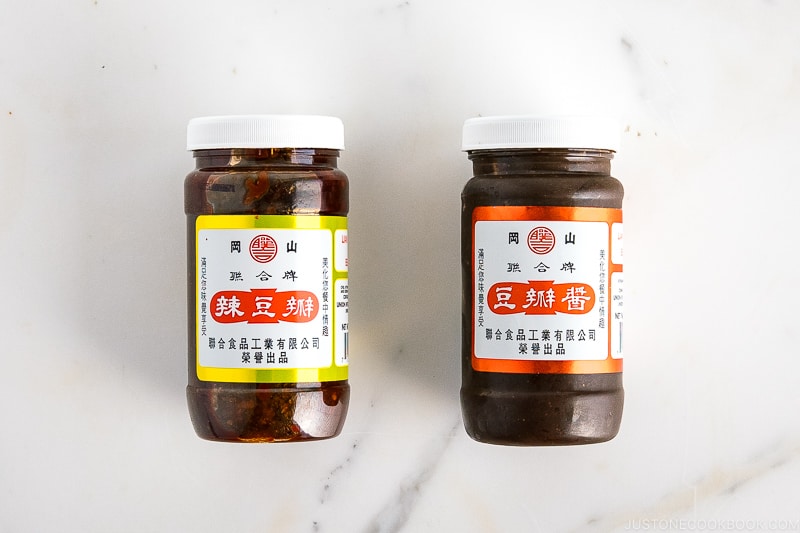
When the kids were small, I use only non-spicy doubanjiang to make my Mapo Tofu and Miso Ramen. Taiwanese brands like Kangshan (岡山) (above) and Ming Teh (明德) offer the doubanjiang made from fermented broad beans and soybeans, and they usually have both spicy and nonspicy versions.
You can get these Taiwanese brands at a local Chinese grocery store. Amazon does not sell the non-spicy doubanjiang at this time (please let me know if you find one).
- Ming Teh Doubanjiang (non-spicy)
- Kangshan Doubanjiang (non-spicy) – Walmart
- Kangshang Doubanjiang (non-spicy) – Weee!
Doubanjiang Substitute: If you really can’t find doubanjiang, you can use gochujang (Korean chili paste; spicy) or doenjang (Korean soybean paste; non-spicy). However, the ingredients are slightly different and have different flavor profiles.
3. Sesame Seeds and Sesame Oil

Sesame flavor in this recipe is prominent as both sesame seeds and oil make the broth nuttier and richer, adding a nice aroma and flavor to the ramen soup.
Japanese households always have a set of suribachi (mortar) and surikogi (pestle) to grind sesame seeds, but if you don’t have one, you can crush the sesame seeds with a food processor (or a coffee bean grinder).
The type of sesame oil you need is dark roasted sesame oil. It has a deep flavor of sesame and only 1 tablespoon would give plenty of fragrance to the soup.
4. Homemade or Store Bought Chicken Broth
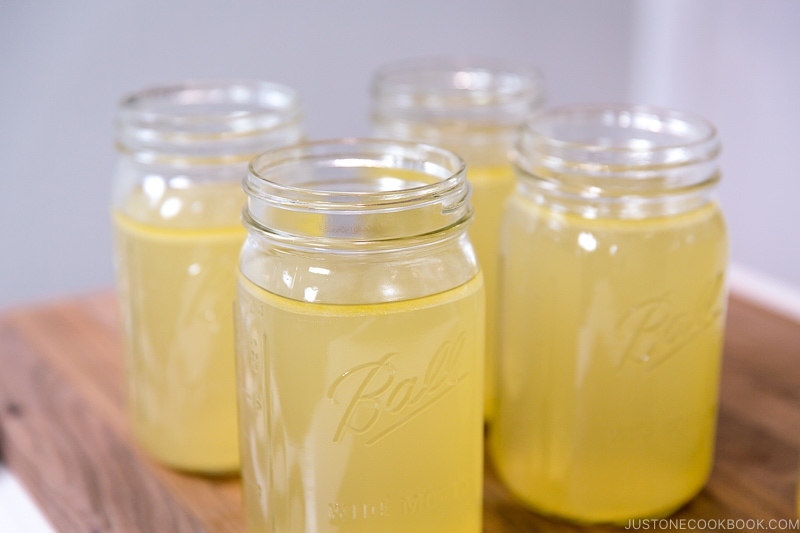
For a richer and more flavorful broth, homemade chicken stock is best. But it’s okay to use store-bought broth to make ramen soup if you don’t have the time.
I like chicken stock from Trader Joe’s. Use less sodium stock and adjust the salt according to your liking. Remember, some chicken stock can be saltier, so you always have to taste your soup before adding salt.
5. White Pepper Powder
I believe white pepper powder is a magical spice in Chinese-style soups and fried rice. Just a few sprinkles of white pepper will elevate the flavor and add a nice kick without the spiciness. You can find white pepper powder in Asian grocery stores or specialty spice shops.
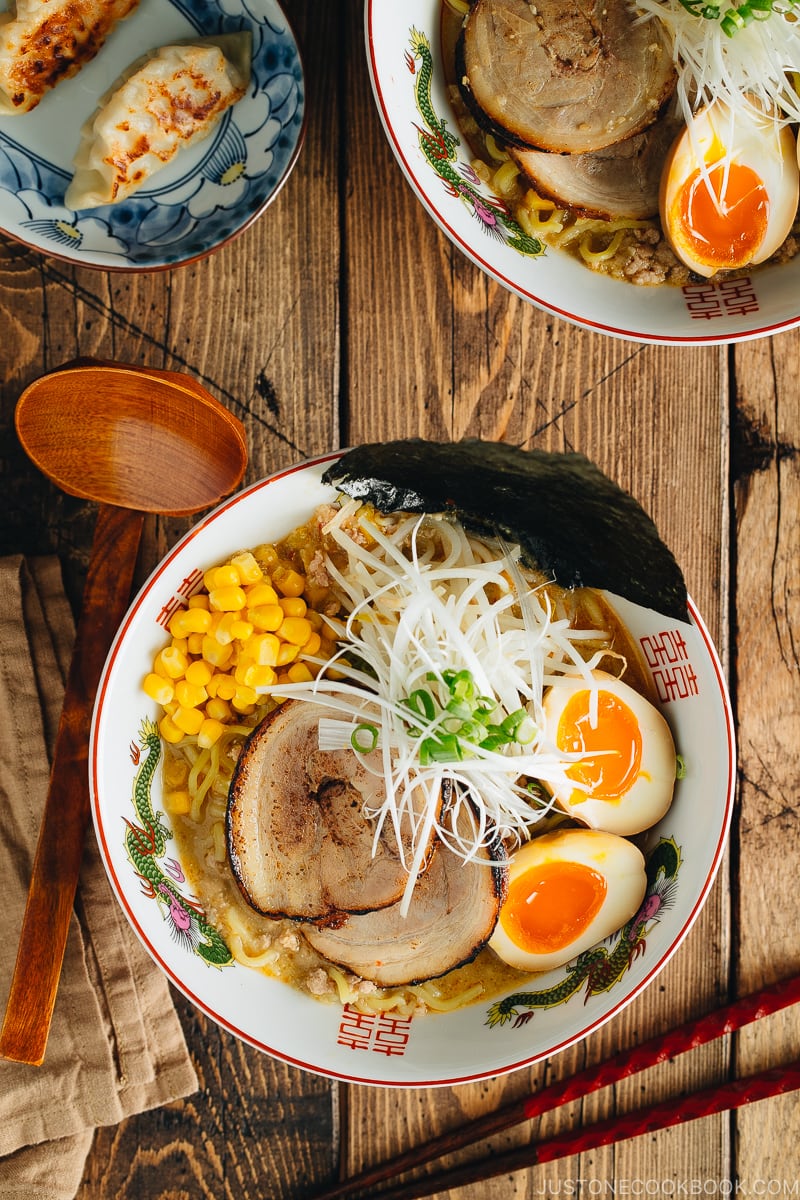
FAQs for Ramen Soup
Do we need to add sugar?
Sugar is not added to sweeten the dish, but it is there to counter the saltiness of miso and doubanjiang (fermented bean paste). Try adding 1 teaspoon at a time and taste the soup before adding more.
Do we need to use sake?
Unless you can’t use it due to religious reasons, I strongly recommend using sake in Japanese cooking. Sake is an essential ingredient such as soy sauce and mirin in Japanese cooking. In this recipe, sake removes the unwanted smell from the meat and adds a subtle sweetness and umami to the soup. The best substitute would be dry sherry and Chinese rice wine.
Part 2: Ramen Noodles 麺
Ramen noodles are made from four basic ingredients: wheat flour, salt, water, and kansui (かん水, saltwater). Kansui is a type of alkaline mineral water, containing sodium carbonate and usually potassium carbonate, and sometimes a small amount of phosphoric acid. Although the color of the ramen noodles is yellowish, they are not egg noodles.
1. Fresh Noodles

Ideally, fresh ramen noodles are the best. My favorite ramen noodles are from Sun Noodles, and I usually make my own soup instead of the soup base that comes with the package.

Fresh noodles are available in the refrigerated section of Japanese grocery stores and some Asian grocery stores. Some stores may keep the fresh ramen noodles in the freezer, so don’t forget to check both sections.
Fresh gluten-free ramen noodles can be purchased from Kobayashi Seimen. They are made from rice and taste very similar to fresh ramen noodles.
2. Dried Noodles

For those who don’t have access to fresh ramen noodles, you can use dried noodles. I’ve tried HIME Japanese ramen noodles (you can purchase them on Amazon) and they are pretty good.
3 Tips for Cooking Ramen Noodles
There are three important tips I want to share with you when cooking ramen noodles.
- Boil the ramen noodles in a big pot of water.
- Do not salt the water like pasta.
- Ramen noodles cook really fast. So make sure to prepare everything ahead of time. Once the noodles are cooked, you have to serve the ramen fast—in less than 30 seconds!
Part 3: Ramen Toppings トッピング
Choices are yours. Here are 7 toppings I added to this Miso Ramen recipe. Even though you would spend less than 30 minutes preparing the ramen on the day of eating, I do spend one day, usually the previous day, preparing my ramen toppings.

Main Toppings
- Chashu – braised pork belly
- Ramen Egg (Ajitsuke Tamago) – eggs marinated in soy sauce base sauce
- Menma (Seasoned Bamboo Shoots)
- Shiraga Negi – julienned white negi/leeks
- Narutomaki (Japanese fish cakes)
- Sweet corn
- Chopped green onion
- Nori seaweed
Other Topping Ideas:
- Wakame seaweed
- Blanched Bean Sprout (or spicy version)
- Blanched greens (bok choy, spinach, etc.)
- Thinly sliced butter (to make it “miso butter ramen”)
- Or anything you like, tofu, shiitake mushrooms, vegetables such as bean sprouts, garlic chives, etc
Now that you have the template on how to make the best miso ramen at home, it’s time to impress yourself or someone you love with your bowl of ramen goodness. It’s really simple, and dare I say more gratifying than the bowl from your ramen joint!
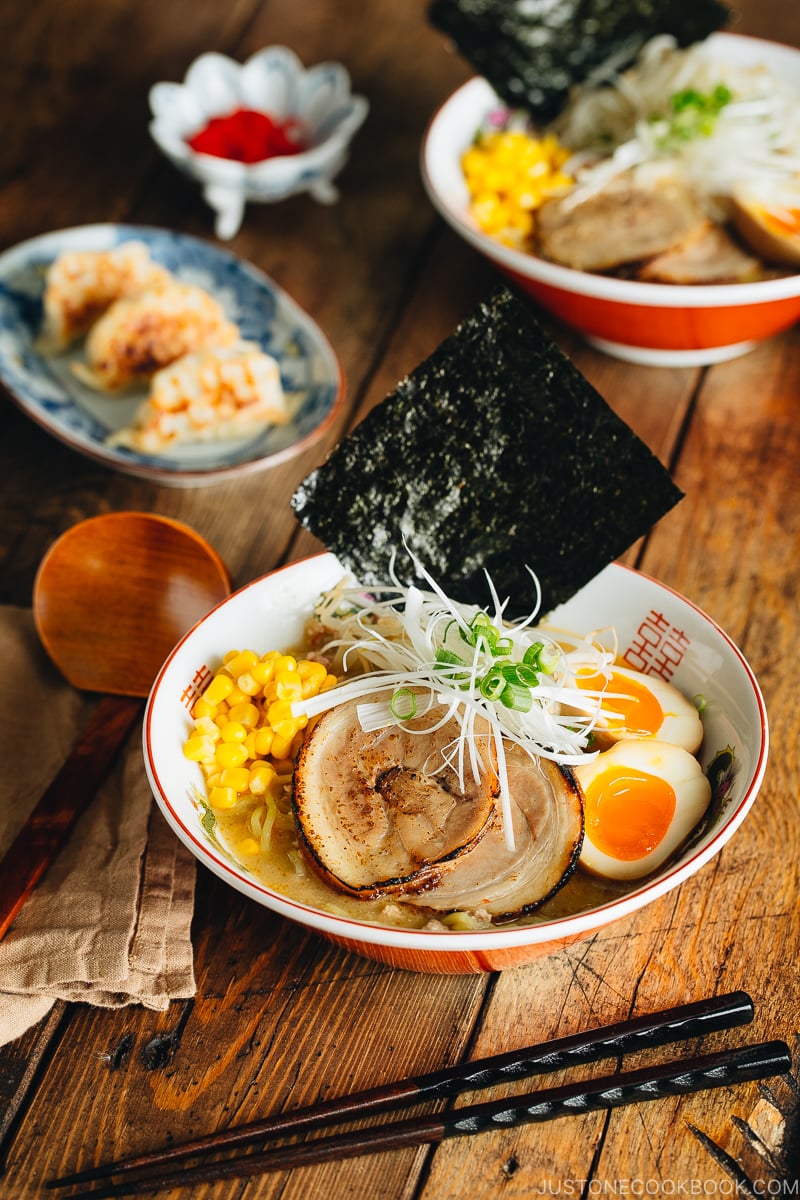
More Ramen Recipes You’ll Love
- Vegetarian Ramen (with an amazingly rich & creamy broth)
- Spicy Shoyu Ramen
- Tsukemen (Dipping Ramen)

Wish to learn more about Japanese cooking? Sign up for our free newsletter to receive cooking tips & recipe updates! And stay in touch with me on Facebook, Pinterest, YouTube, and Instagram.

Miso Ramen
Video
Ingredients
For the Soup Broth
- 2 cloves garlic
- ½ tsp ginger (grated)
- 1 shallot
- 1 Tbsp toasted white sesame seeds
- 1 Tbsp toasted sesame oil
- ¼ lb ground pork (use meat alternatives or chopped mushrooms for vegan/vegetarian)
- 1 tsp doubanjiang (spicy chili bean paste) (use the non-spicy or spicy type or gluten-free doubanjiang)
- 3 Tbsp miso (most types will work except Saikyo and Hatcho; each type will create a slightly different broth flavor)
- 1 Tbsp sugar
- 1 Tbsp sake
- 4 cups chicken stock/broth (use vegetable stock for vegan/vegetarian)
- 1 tsp Diamond Crystal kosher salt (to taste)
- ¼ tsp white pepper powder
For the Ramen Noodles
- 2 servings fresh ramen noodles (10–12 oz (283–340 g) fresh noodles or 6.3 oz (180 g) dry ramen noodles; for gluten-free, use GF ramen noodles)
For the Toppings (optional)
- Homemade Chashu (Japanese Braised Pork Belly) (make my Chashu at least a day in advance or buy it premade at a Japanese market; skip for vegan/vegetarian)
- Spicy Bean Sprout Salad (or blanched bean sprouts)
- Ramen Egg (Ajitsuke Tamago) (make my Ramen Eggs at least a day in advance; skip for vegan; slice in half lengthwise to serve)
- frozen or canned corn (drained)
- nori (dried laver seaweed) (cut a sheet into quarters)
- green onion/scallion (chopped)
- Shiraga Negi (julienned long green onions)
For the Condiments (optional)
- la-yu (Japanese chili oil) (make my Homemade La-yu)
- pickled red ginger (beni shoga or kizami beni shoga)
- white pepper powder
Instructions
Before You Start…
- Prepare the ramen toppings ahead of time—a day in advance for the Homemade Chashu (Japanese Braised Pork Belly) and Ramen Egg (Ajitsuke Tamago)—so they‘re ready to serve with your piping-hot bowl of ramen.
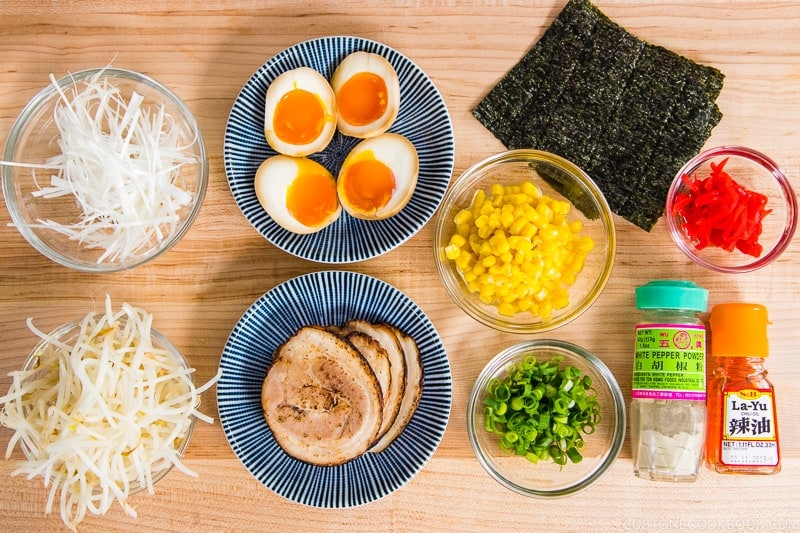
- For toppings, I add chashu, ramen egg, blanched bean sprouts (or Spicy Bean Sprout Salad), frozen or canned corn, Shiraga Negi (julienned long green onions), chopped green onion/scallion, and a quarter sheet of nori (dried laver seaweed). You can find the recipes in the hyperlinks. For the optional condiments, prepare a bottle of la-yu (Japanese chili oil), pickled red ginger (beni shoga or kizami beni shoga), and some white pepper powder on the table.
To Prepare the Ingredients
- Gather all the ingredients.

- Mince or press 2 cloves garlic (I use a garlic press) and add to a small plate. Then, grate the ginger (I use a ceramic grater) and add ½ tsp ginger (grated) to the plate.

- Mince 1 shallot and add to the plate. Set the ingredients aside.

- Grind 1 Tbsp toasted white sesame seeds, leaving some seeds unground for texture. Set aside.
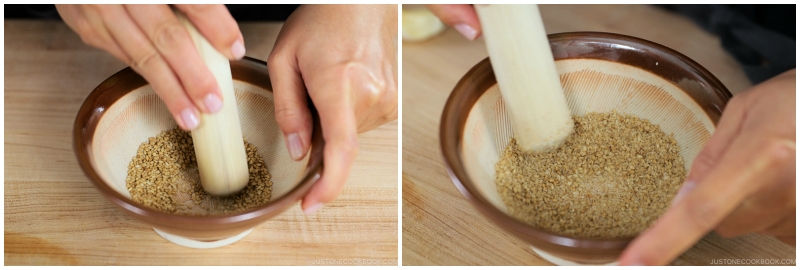
To Make the Soup Broth
- Preheat a medium pot over medium-low heat. When it‘s hot, add 1 Tbsp toasted sesame oil. Then, add the garlic, ginger, and shallot.

- With a wooden spatula, stir-fry until fragrant.
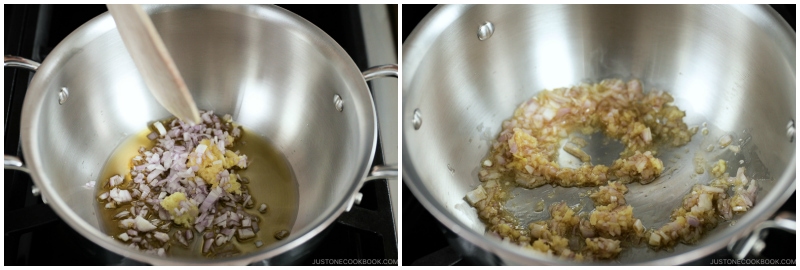
- Add ¼ lb ground pork and increase the heat to medium. Cook the meat until it‘s no longer pink.

- Add 1 tsp doubanjiang (spicy chili bean paste) and 3 Tbsp miso. Quickly blend well with the meat without them getting burnt.

- Add the ground sesame seeds and 1 Tbsp sugar and mix well.
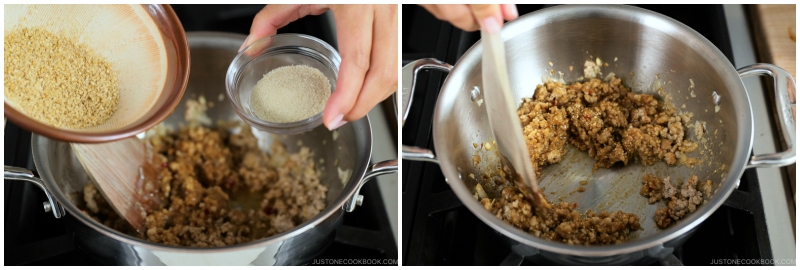
- Add 1 Tbsp sake and 4 cups chicken stock/broth and bring the mixture to a simmer.

- Taste your soup and add up to 1 tsp Diamond Crystal kosher salt (if necessary) and ¼ tsp white pepper powder. Tip: Each brand of chicken stock varies in saltiness, so you must taste your soup to decide how much salt to add.

- Your soup broth is now done. Cover with the lid and keep the soup broth simmering while you cook the noodles.

To Prepare the Ramen Noodles
- Bring a large pot of unsalted water to a boil (ramen noodles already include salt in the dough). When the water is boiling, ladle some of the hot water into the individual ramen bowls to warm them up. Meanwhile, gently shake 2 servings fresh ramen noodles with your hand to separate and loosen them.

- Cook the noodles according to the package instructions. I cook the noodles al dente so they're still firm, about 15 seconds less than the suggested cooking time. Before your noodles are done cooking, empty the hot water from the warmed ramen bowls.

- When the noodles are done, quickly pick them up with a mesh sieve and shake out the excess water. Make sure to drain it well, as you don’t want the boiling water to dilute your soup. Serve the noodles into the warmed bowls.

To Serve
- Add the piping-hot ramen soup broth to each bowl.

- Place the toppings of your choice on the ramen noodles and serve immediately. Add the optional condiments and enjoy.

To Store
- You can keep the soup broth in the refrigerator for 3 days. Cook the noodles right before serving.
Nutrition
Editor’s Note: This post was originally published in May 2011. New video and photos are added in September 2014. The video and images have been updated in May 2019. The post has been republished in February 2022.
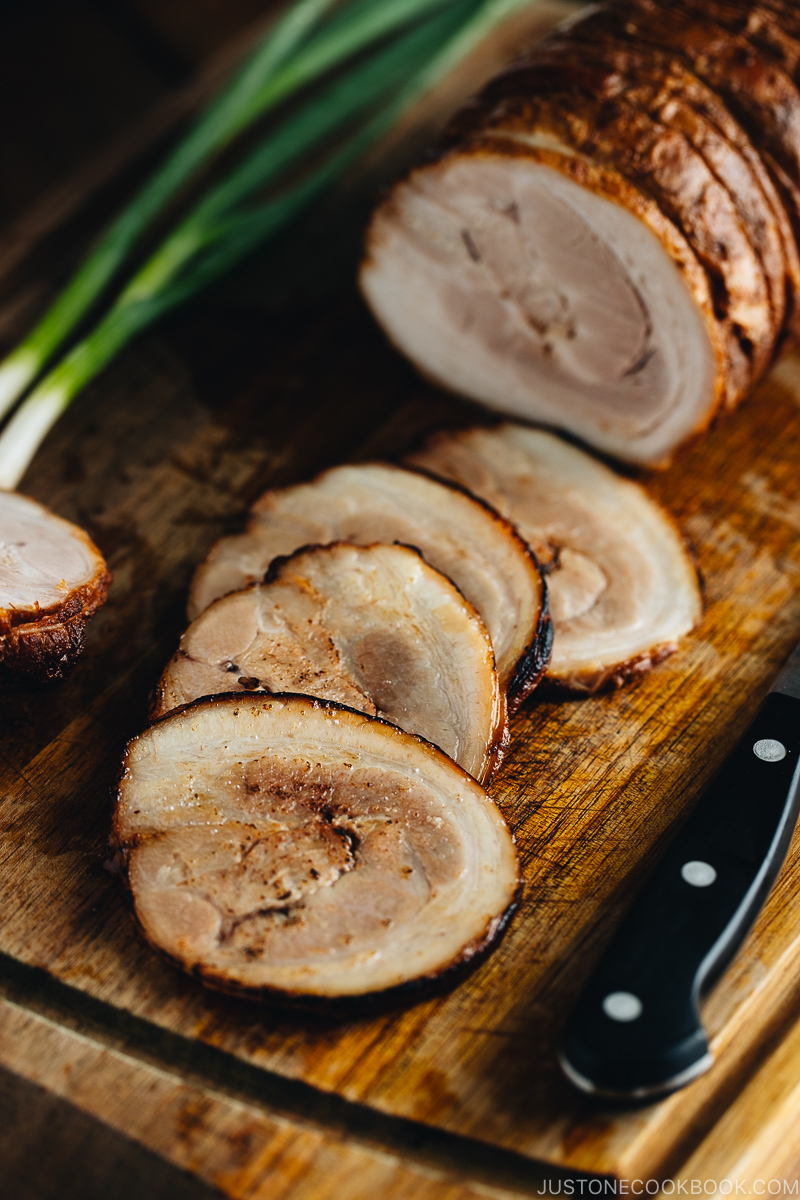


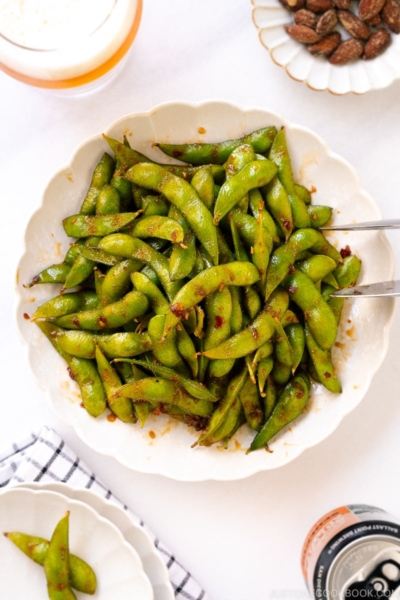






We have a Sun Noodle factory here in Hawaii and once you eat fresh noodles, there’s no going back to dried! And homemade broth is so much better than (salty) packaged ones! Thank you for sharing your ramen series! Hope to try some when the weather gets cooler here!
Hi Donna! I realized that when I was checking their site! I agree. I haven’t eaten dried noodles for ages! Yes, I was hoping that my soup would be “close” to Sun Noodle’s broth, but I was pleasantly surprised mine tasted better… LOL at least to me. =P It’s 80-90F here today. No ramen for a while. 🙂
I’m kind of glad that I just ate dinner because otherwise, I would have been craving that bowl of ramen. It looks so delicious, and I really enjoyed this ramen series. I also had no idea that there was a color-coding across the board—that certainly is hlepful to know On another note, your kids look fantastic in their karate uniforms, and I hope that they had fun at their lesson!
Hi Kimmi! Haha thank you so much for your sweet words. I didn’t realize until I took that picture in the supermarket and realized how neatly arranged by colors… And thank you. <3 My kids love going to karate everyday!!!
look yummy what if you dont eat pork is there anything similar to replace it with?
Hi Cat! You can put seafood if you like. Beef is not common meat for ramen, and chicken is okay to use if you like… but I’d put seafood and more kinds of vegetables. 🙂
Thank you Nami. I like Miso Ramen and have eaten Sapporo Miso Ramen several times, especially spicy Ramen. Do you think your recipe might be similar to Sapporo Miso Ramen?
Rogelio, ramen is VERY hard to compare because each ramen shop tries really hard to be distinct. In general, miso ramen is similar – miso flavor, but the broth can be very different in each shop. Plus, the restaurant usually spends days to make just the broth, so mine is not comparable to the restaurant broth… I think this is very good broth considering it’s made from ground meat in a short time. Hope that helps. 🙂
HI
What is a substitute for Doubanjiang?
thx
Hi Joe! I’m sorry for my late response (I’m traveling in Japan right now…very sorry!). It gives really good flavor so I hope you could find it… but if you can’t, try Korean version, gochujang. It gives depth in flavor so I really think it’s an important part of ingredients. Hope that helps! 🙂
That looks so delicious nami I can’t wait to try it out!
I just have one question: can you replace the pork ground with beef ground? I’m having a muslim friend over for dinner and she loves ramen so I really wanna make it for her.
Keep doing what you’re doing 😀
Hi Cille! It’s not common to have “beef” and “chicken” ramen in Japan, but I think anything can be possible. 🙂 Thank you so much for your kind words and support! Hope you all enjoy the ramen!
Dear Nami,
I really enjoy your blog and the recipes! I was wondering whether you might have a good recipe for soymilk ramen? Apparently, there is none in the Western-language blogosphere, I have been searching for quite a while…..
I would be most delighted to get it from someone who really knows Japanese food!
Best wishes, Georgiana
Hi Georgiana! Thank you so much for your kind words. 🙂
I’ve never tasted Tonyu (soymilk) ramen before, but I researched a bit about it.
The most important part of ramen is always the base soup. It looks like some people make the soup with chicken stock + soymilk + miso and others make kombu dashi + soymilk + miso Unless you prefer “light” version, I’d go with chicken stock. Some people make it spicy by addindg gochujung (korean bean paste).
For soup:
1 cup soy milk
1/2 cup chicken stock
grated garlic (1 clove)
1/2 Tbsp. miso
(1 tsp. soy sauce – optional)
Stir fry pork belly (or bacon), napa cabbage, etc as toppings.
Hope this quick recipe will help you get started. I have never tried…but it seems like above recipe is pretty general. You might need to adjust according to your liking. I’ll try Soymilk Ramen next time I go back to Japan and try making on my own one day. 🙂
I love this recipe, made it for dinner the other day after a long day at work. I didn’t make chashu myself but still so delicious. Thanks Nami! You have changed my life!
xx
Hi Megan! Thank you so much for leaving your feedback here. I’m impressed that you cooked this after work! So happy you liked the broth. Thank you for trying this recipe! 🙂
This is an awesome recipe! I felt like I was back in Japan, but it actually tasted better homemade. If I could only slice the chashu like a pro. Mine kept on falling apart. Nevertheless, it was extremely flavorful and absolutely delicious. The whole soup was a little slice of heaven!
I’m happy to hear you enjoyed this recipe! Thank you so much for giving me your feedback! 🙂
I made this, along with your Chashu Pork for my boyfriend’s birthday instead of a cake. It was so easy to make, and so very tasty! I even managed to cook it in a teeny tiny caravan on holiday. I am about to now make this for my whole family! Thank you so much for this fantastic recipe.
Love Heather! xx
Hi Heather! Yay! I’m happy to hear you liked it! Wow this must be the very first chashu miso ramen cooked in a caravan!! Thank you so much for your feedback! You made my day. 🙂
OMG! This was amazing! I made it yesterday. Couldnt find the konbucha for the chashu but I will order it online. Thanks you so much for sharing!
Hi aangita! I’m so happy you liked it! 😀 It’s not the same as good ramen shop, but I have to say this is pretty good for homemade. Thank you so much for your feedback!
Nami – If I wanted to serve 6 people. Would you say just double the ingredients?
Thanks so much again.
Hi Patrick! Yes, please multiply according to your servings. You need soup for the ramen, so it shouldn’t be short on soup. 🙂
im not a cook was never taught but my husband was by his grandmother. im a fan of naruto and i wanted to try miso ramen but i live in a little town in the middle of no where oklahoma and no good ramen shops. so i decided to do it on my own i made my noodles from scratch and went looking for a good recipe after searching i found yours it was very simple for me to follow along and it is wonderful thanks for everything
Hi Brandi! Wow you made your own noodles too?! That’s amazing! I’m so happy to hear that you liked the recipe. Did you find naruto in your area? It was really my pleasure that you enjoyed this ramen and thank you so much for letting me know. I really appreciate your feedback! 🙂
This sounds Delish I’m considering cooking this for an upcoming dinner date and my local market has no sake.
will it make much of a difference and is the something that i can substitute instead.
Hi David! We often add sake to our cooking to add flavor and sometimes reduce the smell of meat/fish etc (similar to adding wine for cooking). If you can find Chinese rice cooking wine that’s okay too. I recommend to buy a cheap bottle of sake if you can find in Chinese market. If not, dry sherry might work too. I learned that’s a substitute for Chinese rice cooking wine. I hope you will like this recipe. Thank you for trying!
I am in love with your site! Just moved into a new apt with my bf and am looking forward to cooking some delicious meals from your site 🙂 thank you!
Hi Ashley! Thank you for stopping by my blog! It must be fun cooking with/for your boyfriend. I’d love to help so let me know if you have any question! 🙂
Hi, I just wanted to say thank you for the recipe and the excellent instructions. They were really easy to follow. I made this yesterday (having never made Japanese food before) and it was so wonderful. Took me a little while to get all the toppings together (i burnt the chashu a little because I forgot to keep mixing it but it was great nevertheless) and well worth the effort. I have missed ramen and this made me so happy! Will try my hand at more of your recipes!
Hi Shai! Awww! I am so happy to hear that you enjoyed your home-cooked ramen! Thank you so much for your kind feedback. I’ll be here, and if you have any question, I’ll be happy to help you cook Japanese food at home! xo
Hi Nami,
I can’t find sake near me but i have shaoxing wine. Is that the same as Chinese rice wine?
Hi Judy, Shaoxing wine is traditional Chinese wine and can be used as a substitute for Sake. We hope this helps!